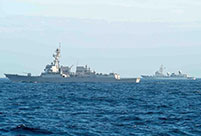

WASHINGTON, March 16 -- U.S. space agency NASA said Wednesday it will intentionally light a "large-scale fire" on an unmanned cargo spaceship scheduled for launch next week as part of an effort to increase understanding of how an accidental fire might behave in space.
NASA has planned three such space flight safety experiments, all conducted inside the Orbital ATK Cygnus resupply vehicle, not on its way to the International Space Station, but rather after it leaves the orbiting lab and before it re-enters Earth's atmosphere.
"NASA's objective is to reduce the risk of long-duration exploration missions, and a spacecraft fire is one of the biggest concerns for NASA and the international space exploration community," said Jason Crusan, NASA's Advanced Exploration System director, in a statement.
The Spacecraft Fire Experiments, or Saffire, will be performed during the next three consecutive flights of the Cygnus vehicle, with the first scheduled for launch on March 22 from NASA's Kennedy Space Center in Florida.
The experiments, to be remotely conducted by researchers on Earth, will take place in a three-by-three-by-five foot(0.9-by-0.9-by-1.5 meter) tall module carried aboard Cygnus.
NASA said it purposefully set fire to materials in space for research previously, but those samples have been limited to 10cm in length and width.
The first Saffire experiment, however, will assess a large-scale microgravity fire using sample material about 0.4 meter wide and1.0 meter long, it said.
The second will assess oxygen flammability limits using samples about 5cm wide and 30cm long while the third will assess a second large-scale microgravity fire.
"Saffire will be the biggest man-made fire ever in space," said Gary Ruff, NASA's Spacecraft Fire Safety Demonstration project manager.
"Currently, we can only conduct small combustion experiments in the microgravity environment of the space station. Saffire will allow us to safely burn larger samples of material without added risk to the station or its crew."
Images and data captured from inside the Saffire module will be transmitted to Orbital ATK and relayed to NASA prior to Cygnus' destructive reentry to Earth.
Researchers from NASA and its partners will analyze the data and use it to further develop technologies to safeguard future astronauts from a spacecraft fire.
 Beautiful Kapok flowers bloom in Hainan
Beautiful Kapok flowers bloom in Hainan Eye-catching beauties in Chunxi Road of Chengdu
Eye-catching beauties in Chunxi Road of Chengdu Wedding pictures of Wu Qilong, Liu Shishi released
Wedding pictures of Wu Qilong, Liu Shishi released One of world's largest military drills in Saudi Arabia
One of world's largest military drills in Saudi Arabia Iron lady or goddess? Sportswomen's dress show
Iron lady or goddess? Sportswomen's dress show Versatile female soldiers in military camp
Versatile female soldiers in military camp Top beauties in Chinese provinces
Top beauties in Chinese provinces Follow me to my Weibo
Follow me to my Weibo Chinese ships keep close watch on U.S. Navy aircraft carrier strike group in S. China Sea
Chinese ships keep close watch on U.S. Navy aircraft carrier strike group in S. China Sea Top 20 hottest women in the world in 2014
Top 20 hottest women in the world in 2014 Top 10 hardest languages to learn
Top 10 hardest languages to learn 10 Chinese female stars with most beautiful faces
10 Chinese female stars with most beautiful faces China’s Top 10 Unique Bridges, Highways and Roads
China’s Top 10 Unique Bridges, Highways and Roads Meet Beijing’s hottest new trend: vaping
Meet Beijing’s hottest new trend: vaping Govt to increase scrutiny of online retail: report
Govt to increase scrutiny of online retail: report China’s logistic hub in Djibouti to stabilize region, protect interests
China’s logistic hub in Djibouti to stabilize region, protect interests Myanmar won’t distance itself from China
Myanmar won’t distance itself from ChinaDay|Week